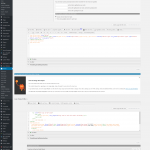Hi Eduardo
As I described above, you can only output the information about what the "current" taxonomy term is on your search page inside the loop output section, because outside that the post from which the taxonomy information would be taken is the page where you are adding the view (which doesn't have it).
Alternatives where you could access the taxonomy information would be to create a taxonomy archive (but you can't filter by the same taxonomy on a taxonomy archive) or by creating nested views with the outer view a taxonomy view which lists the taxonomy terms and an inner view which lists the posts for that term, but the problem in this case is that you can't use search filters on a taxonomy view.
Which means going back to the proposal above.
Let me first make one observation, which is that your view loop output section links to a content template "Loop item in view for detail filtered", and all that content template contains is a call to another content template "content-for-detail-page". So the first of these is redundant, you can just link directly to the content-for-detail-page view directly from the loop output section.
So your loop output section will need to look like this:
<wpv-loop>
[wpv-item index=1]
[wpv-conditional if="( is_being_filtered() eq 'true' )"]
<h2>[wpv-post-taxonomy type="content-type" format="name"]</h2>
<h3>[wpv-post-taxonomy type="content-type" format="description"]</h3>
[/wpv-conditional]
<li>[wpv-post-body view_template="content-for-detail-page"]</li>
[wpv-item index=other]
<li>[wpv-post-body view_template="content-for-detail-page"]</li>
</wpv-loop>
You will also need to register a custom function to check whether a filter is being applied for the taxonomy, by adding the following to your theme's functions.php file or using a plugin such as Code Snippets. Note that you will need to edit the taxonomy slug (which in my example is 'content-type').
function is_being_filtered() {
$taxonomy = 'content-type'; // edit as required
if ( isset( $_GET['wpv-' . $taxonomy] ) ) {
if ( '0' != $_GET['wpv-' . $taxonomy] ) {
return "true";
}
}
return false;
}
That function checks whether a url parameter for the taxonomy filter has been added, and you will need to register it to be used in the conditional shortcode at Toolset > Settings > Front-end Content.
Then the way this works is that for the first item in the loop it will output the name and the description of the taxonomy term assigned to that post. But we don't want to display it when your radio filter is set to display all (e.g. on initial page load), which is why we add the conditional shortcode to check whether the filter is being applied or not.
I don't believe there is another way of doing this that doesn't extract the taxonomy information from the first filtered result, which means you may need to use some CSS to make the taxonomy title and description stand out from the list of post results.
